Note4Students
From UPSC perspective, the following things are important :
Prelims level: Space Weather, Solar Supergranular Cells

Why in the News?
- Astronomers from the Indian Institute of Astrophysics (IIA) have developed a new method to predict the amplitude of the upcoming solar cycle.
- This discovery is based on 100 years of solar data from the IIA’s Kodaikanal Solar Observatory.
What is Space Weather?
Solar Cycle and Its Importance
|
Research Findings
- IIA researchers discovered that the width of supergranular cells on the solar surface during the minimum year of the solar cycle is correlated with the number of sunspots observed during the subsequent solar cycle maximum.
- This simple method can be used to predict the strength of the upcoming solar cycle, which is valuable for space weather forecasting.
What are Supergranular Cells?
- Supergranular Cells are large convective cells on the Sun’s surface, with diameters of about 30,000 km.
- These cells are part of the solar convection zone where hot plasma rises, cools as it reaches the surface, and then sinks back down in a continuous cycle.
- Characteristics:
- Supergranular cells are larger than granules, another type of convective cell on the Sun. Its borders, known as supergranular lanes, are about 5,000 km thick.
- Plasma within these cells moves from the center of the cell toward the edges, where it sinks back into the Sun’s interior. This movement creates a network of lanes that can be observed on the solar surface.
- Supergranular cells are associated with the magnetic field concentrations on the Sun’s surface, often where sunspots and other magnetic features appear.
PYQ:[2022] If a major solar storm (solar flare) reaches the Earth, which of the following are the possible effects on the Earth?
Select the correct answer using the code given below: (a) 1, 2, 4 and 5 only |
Get an IAS/IPS ranker as your 1: 1 personal mentor for UPSC 2024

